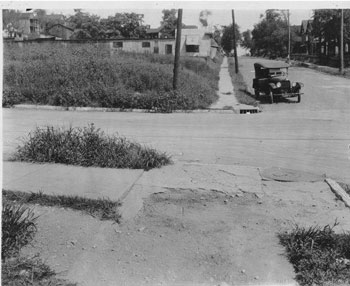
Cracked, chipped and leaf-covered sidewalks are some of the problems Sara Murphy and her children encounter when they walk in Hyde Park. Murphy is among a number of Midtown residents who wonder why sidewalks are so hard to maneuver.
In this first report in the MidtownKC Walks series, Kansas City residents, especially those in Midtown, say they are more dissatisfied with the condition of sidewalks than almost any other city service. Tomorrow, residents say they are surprised to learn that responsibility for sidewalk maintenance lies with individual property owners, and the cost of repairs can be a challenge for some. As the series continues this week, we’ll learn why demand for well-maintained sidewalks is increasing, what other cities are doing, and what could be in Kansas City’s future.
MidtownKC Walks Project is a joint project of the Midtown KC Post, BikeWalkKC and The Whole Person. Join a conversation about sidewalks on the Midtown KC Walks page or comment on these stories. We also have a survey about your experiences walking in Midtown and a map where you can mark sidewalk problems you encounter. Join the MidtownKC Walks mailing list for updates on the project.
For the past several years, Midtown residents, along with others across the city and the country, have been increasingly vocal about one issue: the condition of sidewalks. In fact, when the city does its annual citizen satisfaction survey, sidewalks rate at the top of complaints.
Sara Murphy, a Hyde Park mother, says her family, including five-year-old son Jack, uses the sidewalks on a daily basis.
“I run. Jack rides his bike. We do some family bike rides and walk to the park, the Nelson and friends’ houses,” she says.

In the 2015 Citizen Satisfaction Survey, the combined importance of sidewalks and dissatisfaction with their condition made them the second highest area of dissatisfaction among city residents. Results from Kansas City Citizen Satisfaction Survey fiscal year 2014/2015.
But Murphy wonders why the sidewalks are so ragged and hard to navigate.
“They are dangerous in some parts, especially now that it gets dark so early. Its easy to trip on them if you are not paying attention.”
When the Midtown KC Post ask readers what topics they wanted to hear city council candidates discuss this year, they mentioned increased home ownership, code enforcement and schools, but the most interest lay in transportation issues. A number of readers said they wanted to hear the candidates talk about sidewalks.
For the past few years, sidewalks have been registering among the top complaints citizens voice through the annual Citizen Satisfaction Survey, a tool for measuring how residents feel about city services. Officials use it as a way to gauge citizens’ priorities for different services.
In the city manager’s office, Deputy Performance Officer Kate Bender helps monitor and analyze citizen satisfaction. She says sidewalks rank second only to street maintenance when services people rate as important are cross indexed with dissatisfaction.
Yet in a period when overall satisfaction with city services has been going up, dissatisfaction with sidewalks remains high. For the past decade, more Kansas City residents have been dissatisfied with sidewalk conditions than have been satisfied or neutral, and the level of satisfaction has been lower in Kansas City than in other cities of comparable size.

For the past decade, more Kansas City residents have been dissatisfied with the condition of sidewalks than satisfied or neutral. City residents are also more dissatisfied than people in comparably-sized cities. Results from Kansas City Citizen Satisfaction Survey fiscal year 2014/2015.
While people are somewhat more satisfied with the conditions of sidewalks in their own neighborhoods compared to the city in general, the highest levels of dissatisfaction are found in the 3rd and 4th council districts, which include Midtown. The 4th district has the highest dissatisfaction rate, with 47 percent of residents being either dissatisfied or very dissatisfied. In the 3rd District, the rate is 44 percent. In other parts of the city, the more southern 5th and 6th districts show higher levels of dissatisfaction (43 and 46 percent) than the northern 1st and 2nd districts (32 and 33 percent).

Cutline: Street scene in a residential district 1922. Courtesy Kansas City Public Library/ Missouri Valley Special Collections.
People in Kansas City have been unhappy about sidewalks since the first ones were laid in the 1860s. The first were wooden planks, later replaced by concrete. But the city faced a problem that still makes sidewalk maintenance problematic – by law, responsibility for the sidewalk lies with the property owner. That meant, in the early days, that there might be a sidewalk in front of a new home – and no sidewalk in front of the undeveloped properties around it. It also led to blocks with sidewalks made of different materials, and problems with absentee landlords who allowed mud or weeds to make sidewalks impassable.
Because Midtown developed during a period when most people relied on streetcars and their feet for transportation, a complete system of sidewalks was built as the area developed. That’s not always true in other areas of the city, where in places like Waldo sidewalks were left out of the developing infrastructure. And for a while in the 1970s through the 1990s, residents and planners didn’t think sidewalks were as important as streets and automobile routes.
But for the past decade, interest in walkable communities has been increasing, accounting at least in part for the dissatisfaction with sidewalk conditions. One major source of dissatisfaction lies in the policy that individual property owners are responsible for their sidewalks, the topic of tomorrow’s report in our MidtownKC Walks series.



Trackbacks